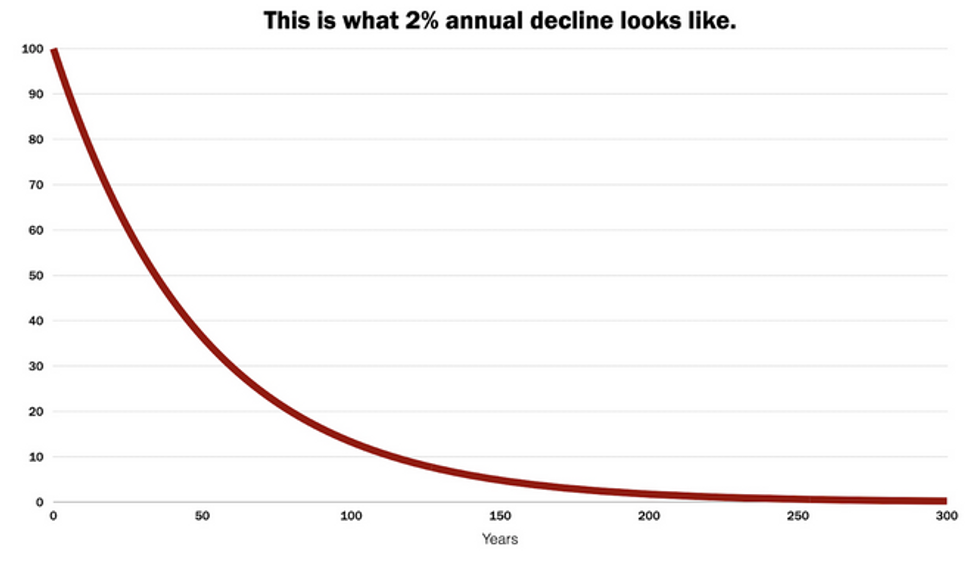We’ve had a summer from hell, with July 2023 temporarily claiming the title of hottest month on record. But while the klaxons of Earth’s climate system have riveted nearly everyone’s attention, something else is silently happening to us and other species that could turn out to be just as big a disaster.
Nature is increasingly stewing in air- and water-borne toxins originating in industrial processes. Tens of thousands of chemicals, only a tiny proportion of which have been tested for safety, are making their way into the environment—from pharmaceuticals that have passed through human bodies, to plastics, pesticides, solvents, fire-retardants, and chemicals used in making cookware coatings.
Recent research shows that whole classes of these chemicals are affecting sexuality and disrupting reproduction—not just in humans, but in a host of other animal species as well. But the whole subject is controversial and is getting far too little attention, partly because reproduction and sexuality are culturally sensitive topics, and partly because the chemicals industry wields considerable political power. In this article, we’ll explore both the science and the controversy, and see why 2 percent is such a scary number in this context.
Sperm Counts, Testosterone Levels, and Women’s Reproductive Health
Multiple studies have shown that male sperm counts have fallen dramatically in the past 50 years. That decline appears to be accelerating.
The fact that both human sperm count and insect biomass are estimated to be declining at about 2 percent per year may be just a numerical coincidence. Nevertheless, it’s a number that should grab our attention.
While the reasons for falling sperm counts are still being investigated, it is clear that the fetus is particularly susceptible to the effects of pollutants, and that impacts at the fetal stage of life can significantly shape the adult. The pollutants most likely to have widespread impacts on reproductive health have been identified—hormone-mimicking chemicals that have become widely dispersed in the environment, many of which persist for decades or longer.
Two meta-studies (i.e., studies based on a review of all relevant research to date) by a team led by Hagal Levine of the Hebrew University of Jerusalem provide the most reliable and broad-based scientific information about sperm counts. The first of these papers, published in 2017, covered data from North America, Europe, and Australia/New Zealand. It found “a significant decline in sperm counts . . . between 1973 and 2011.”
A more recent paper by Levine et al., published in November 2022, confirmed these conclusions and expanded them to include Africa and South America. Among men from all continents, the authors concluded, “the mean [sperm count] declined by 51.6% between 1973 and 2018.” The study also found that the decline rate, currently about 2 percent per year, is increasing. The trend, if extrapolated, would result in near-universal male sterility by about 2060.
Having a low sperm count reduces fertility, though if the count is above zero it does not exclude the possibility of an affected man impregnating his partner. However, a low sperm count is frequently associated with reduced sperm quality, including less motility and abnormal shape.
Testosterone levels in males are also falling. Several reasons have been suggested, with environmental toxins again one of the more likely culprits. Low testosterone levels in men can lead to obesity, low sex drive, and symptoms of depression.
Women are likewise experiencing puzzling and worrisome trends in sexuality and reproduction. Studies in dozens of countries since the 1970s have shown that girls are experiencing puberty earlier and earlier, with the average age of onset declining by about three months with each passing decade (a similar, though less extreme pattern, has been seen in boys).
In her book Countdown: How Our Modern World Is Threatening Sperm Counts, Altering Male and Female Reproductive Development, and Imperiling the Future of the Human Race, reproductive epidemiologist Shanna Swan (a co-author with Levine of the two studies linked above) cites research showing an increase in difficulties in childbirth, increasing incidence of endometriosis, increasing risk of miscarriage, increasing incidence of ovulation disorders, and increasing use of in vitro fertilization.
Swan also explores links between chemical exposure in utero and later gender-related sexual behavior, citing dozens of relevant studies. She writes:
In addition to influencing the physiology of reproductive development, environmental chemicals may be affecting gender identity and sexual preference. These forms of flux aren’t inherently good or bad, but they may present a silver lining: with such trends arguably on the rise, we, as a society, are gradually becoming more open-minded toward accepting people, however they present and identify themselves in terms of gender.
Meanwhile, Americans are having less sex, and young people in particular are reporting less sex drive.
Why Is This Happening?
There are several possible reasons for these ongoing shifts in human reproduction and sexuality. Researchers have explored environmental toxins, obesity, diet, smoking, medications, diabetes, marijuana usage, and aging as factors. It’s difficult to establish perfect cause-and-effect relationships between culprits and outcomes, but all of the worrisome impacts and trends are linked, to one degree or another, with environmental toxins.
Since the 1990s, many researchers who are trying to understand the accelerating increase in reproductive problems have focused on endocrine disrupting chemicals—compounds that either block the action of a naturally occurring hormone or intensify the effects of a natural hormone by eliciting the same physiological response as the hormone itself. Endocrine disruptors include:
- Phthalates, a group of chemicals used to make plastics more durable, found in hundreds of products—from vinyl flooring to lubricating oils and personal-care products (soaps, shampoos, and hair sprays)
- Pesticides and herbicides, including glyphosate, the world’s most widely used weed killer
- Bisphenol A (BPA) and phenol, common in food storage materials
- Polychlorinated biphenyls (PCBs) and brominated flame retardants, used in electronics and building materials
- Per- and polyfluoroalkyl substances (PFAS), “forever chemicals” used as oil and water repellents and coatings for common products including cookware, carpets, and textiles.
Traces of PFAS endocrine disrupting chemicals have been found even in the remotest locations on the planet, and a study released in July 2023 revealed that they contaminate up to half the US water supply.
Public concern over environmental toxins has led the chemicals industry to withdraw certain of its products and replace them with substitutes. Unfortunately, the result is often what anti-toxics activists call “regrettable substitution,” in which substitute chemicals have similar toxicity effects to the chemicals they replacing. For example, GenX and PFBS are being used as replacements for PFOA and PFOS, the original Teflon chemicals that were forced off the market due to their decades-long persistence in the environment and their links to serious health harms to people and wildlife. But GenX and PFBS are also toxic and persistent in the environment. In some cases, the substitute has been found to be even more toxic than the chemical it is replacing: bisphenol F, which is widely used as a substitute for BPA, is even more dangerous to people and the environment.
The sheer quantity of chemicals being dumped into the environment is quickly growing. UNEP counted the annual release of toxic chemicals in 2006 at 6 million tons, but Worldometer estimates the current release at 10 million tons—a 67 percent increase in a little over a decade.
As I was doing research for this article, I came across an opinion piece in Scientific American by endocrinologist Geoffrey Kabat, who claims that there is not enough proof of causal links to justify naming endocrine-disrupting chemicals as the main source of declines in sperm counts. Kabat quotes fellow endocrinologist Richard Sharpe as saying: “Given that we still do not know what lifestyle, dietary or chemical exposures might have caused this decrease, research efforts to identify [the causes] need to be redoubled and to be non-presumptive as to cause.”
Curious, I asked Dr. Pete Myers, founder and chief scientist of Environmental Health News and coiner (in 1991) of the term “endocrine disrupting chemicals,” about Kabat’s and Sharpe’s doubts. Myers told me, “While there is always uncertainty in any scientific hypothesis, the weight of the in vitro, in vivo, and epidemiological evidence strongly supports the involvement of phthalates in the sperm count decline.” Myers also alerted me to an article that traces funding links between the Genetic Literacy Project (which publishes Kabat’s opinion pieces and lists him as an adviser) and Monsanto (now Bayer).
Of course. Just as Big Tobacco once hired PR firms to assure smokers that cigarettes were safe, and just as Big Oil created a network of non-profit think tanks to argue that fossil fuels don’t cause climate change, now Big Chem (Bayer, BASF, Dow, Dupont, and Syngenta) is following the same playbook. And lobbying by the chemicals industry appears to produce results: in just one instance, the US Environmental Protection Agency (EPA) has recently changed how it defines PFAS for regulatory purposes in a way that excludes many known persistent toxins.
It Gets Worse
Perhaps the most frightening biological impact of many endocrine-disrupting chemicals is their tendency to alter DNA expression in ways that can be inherited by subsequent generations. It’s long been known that environmental factors (food, air, water) can cause genes to be switched off or on, or dial their expression up or down. Sometimes the effects are transgenerational, and continued presence of chemicals in the environment can amplify biological impacts from one generation to the next.
For example, a 2017 experimental study on mice found that in utero exposure to phthalates resulted in the first subsequent generation being born with slightly damaged sperm; however, with continued phthalate exposure, by the fourth generation the mice’s capacity to produce sperm was virtually gone. Pete Myers refers to this intergenerational amplification of impacts as a “male fertility death spiral.”
Because chemicals can revise the ways DNA patterns are expressed in cells and body systems, chemical impacts on human reproduction could become permanent. According to Shanna Swan, “It’s as if the new pattern becomes etched in stone and cannot be altered or erased for either that man or possibly his future male heirs.”
As if to add injury to insult, low sperm counts and testosterone levels in men, and poor reproductive health in women, have been shown to be associated with poorer health overall, including shorter lifespans and greater likelihood to develop cancer and heart disease.
But Aren’t There Too Many People Anyway?
Some ecologically minded folks’ initial reaction to the news of falling sperm counts is nonchalance or even elation. After all, population growth makes nearly all environmental problems worse and harder to solve. Human population has risen from one billion at the start of the Industrial Revolution to eight billion today, and for the past several decades we’ve been adding an extra billion to our numbers approximately every twelve years. One might well ask: If humanity will have more difficulty reproducing in the near future, is that just nature’s indirect way of trimming the over-abundance of a particularly destructive invasive species?
It’s bad enough that chemicals could result in a human population crash this century, but other species are being impacted too.
Unfortunately, this way of mentally turning looming tragedy into possible benefit is shortsighted. Only the most misanthropically minded would want humans to go extinct due to an inability to reproduce. However, if some of the accelerating trends cited above were to continue, near-universal sterility would indeed be the result. Even if some people could still reproduce, we might be trapped in a real-life version of The Handmaid’s Tale.
Unsurprisingly, companies, governments, and think tanks that encourage population growth are using news of falling sperm counts to encourage more growth now, while it’s still possible—ignoring the ecological impact of higher human numbers as well as the decline in global human carrying capacity.
It’s Not Just Humans
It’s bad enough that chemicals could result in a human population crash this century, but other species are being impacted too. Take insects, for example. A 2022 metastudy led by Veronika Hierlmeier noted that “The ongoing decline in the biomass, abundance, and species number of insects is an established fact.” Ecologist Bill Rees recently told me, “We may not notice, but insects are the glue, nuts and bolts of many ecosystems. Remove the ‘bugs’ and the rest of the system falls apart. Oh, yeah, the human enterprise is part of ‘the rest of the system’.”
The most recent estimates suggest that insect biomass is declining by up to a startling 2 percent per year. This frightening trend is no doubt partly due to habitat loss. But another major cause appears to be the same chemicals associated with increasing reproductive problems in humans—“forever” chemicals, BPA, phthalates, etc.
The story is similar with other animals. Studies of farmed mink in Canada and Sweden have linked industrial and agricultural chemicals with lower sperm counts and abnormal testicular and penis development. A similar effect has been seen in Florida alligators, in UK crustaceans, and in fish downstream from wastewater treatment plants around the world.
Even species in the remotest regions of the planet are suffering serious chemical contamination. A female orca carcass that washed up on a beach in Scotland in 2017 was found to have “shocking” levels of PCBs. Scientists who examined the whale’s ovaries say she had never been reproductively active, though she was at least 20 years old. Orcas usually start mating at 14.
It’s hard to argue that these reproductive impacts to insects and other animals are due to diet, obesity, or lifestyle choices (which Geoffrey Kabat implies might be largely to blame for falling human sperm counts). Rather, for most humans and other animals that are affected, the obvious and likely culprit, once again, is toxic hormone-mimicking chemicals dispersed throughout the environment.
Death Spiral
The fact that both human sperm count and insect biomass are estimated to be declining at about 2 percent per year may be just a numerical coincidence. Nevertheless, it’s a number that should grab our attention. It may help to visualize what such a decline looks like over time:

Unless the chemical load on the environment is radically reduced, and soon, the stakes may be existential. If sexually reproducing animals, including humans, lose the ability to yield offspring, then in the future the biosphere may host a radically reduced roster of higher life forms.
Meanwhile, we humans must come to terms with a confusing reality in which we face the seemingly contradictory risks of both overpopulation, which is contributing to environmental ruin, and a population crash due to chemical-induced reproductive problems. It’s easy to dismiss one by pointing to the other, but we must somehow grapple with both. The outcomes for all life on Earth will be far better if we support reproductive choice and education for women, and ban phthalates and other toxic chemicals.
Unless the chemical load on the environment is radically reduced, and soon, the stakes may be existential.
Meanwhile, the public should be warned more explicitly and urgently about the perils of chemical exposure, and provided with information about the products most likely implicated.
With regard to climate change one often hears the refrain, “We don’t need to ‘save the planet’; the Earth will be fine, it’s just humans that will suffer.” In reality, some environmental trends now in motion, including the widespread release of endocrine disrupting chemicals, are imperiling all of nature. Are rubber duckies and other plastic crap, overly manicured lawns, throw-away packaging material, and cheap cookware really worth that level of risk?




